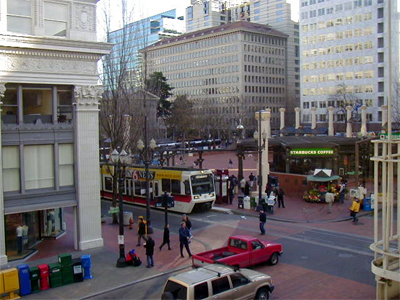Light rail isn't just good for riders; society as a whole benefits from fast, clean, convenient transit.
By Ryan McGreal
Published June 27, 2007
Everyone should support light rail, even people who don't necessarily plan to use it. Light rail is a true public good, a civic infrastructure that helps everyone, not just its direct beneficiaries.
Here are eight reasons everyone in the city should choose light rail over glorified buses.
Light rail costs about half as much to operate as buses - and that's at current fuel prices, which are expected to quadruple over the next decade and a half, according to the city's Peak Oil report.
Since the province (and possibly the feds) will be paying most of the capital costs, it makes sense to pick a system that's easier on the local property tax base. Even Lloyd Ferguson and Dave Mitchell should be able to get behind this.
In addition to a lower operating cost, light rail carries many more people than buses. This maximizes the benefit of the original investment and has better long-term potential to scale up as ridership continues to grow.
Even with dedicated lanes, light rail reduces overall traffic because it carries people a lot more efficiently than an equivalent car lane. That means you benefit from light rail even if you still choose to drive.
It's good that light rail can carry more people than buses, because it's much better at attracting new riders out of their cars. Light rail is the best at generating a net increase in ridership (and a matching net decrease in driving).
If we're going to spend the money, we should make sure we get the most bang for our buck.
Light rail is quiet and produces no emissions at the tailpipe, and can be powered using renewable energy sources (wind, solar, hydro). Even using non-renewable energy, electric rail is several times more efficient than internal combustion at moving people around.
Light rail also takes more cars off the road than buses, which further reduces air pollution and greenhouse gas production.
Light rail can go anywhere: on the road, on the sidewalk, across a plaza, in the air, underground, up the escarpment, and so on. Light rail fits well in an urban environment and easily shares space with other uses.

Light Rail is compatible with cars and pedestrians
Developers absolutely love light rail. It tells them the city has a long-term commitment to servicing a community.
They are also aware that light rail attracts many more voluntary riders than buses and that proximity to a light rail station is a major incentive to homebuyers.
That's why light rail lines regularly generate billions of dollars in new private investment around the lines. As the transportation director for Kinosha, Wis., put it, "Developers don't write cheques for buses."
Because light rail attracts so much investment, it leads dirrectly to intensification around the line, a natural fit with the city's long-term growth strategy.
Main Street could enjoy a dense, mixed streetwall of five- and six-storey buildings with retail and offices below and apartments and condos above.
If the city is smart and recognizes that light rail means less driving, it can even eliminate parking requirements for new buildings adjacent to the line.
That will further reduce the barrier to new investment and will allow more intensive uses on a smaller footprint.
By Dariusz (anonymous) | Posted July 09, 2007 at 13:45:48
Hi Ryan,
This is great, but it's difficult to deal with the fact that people (especially our esteemed local politicians) actually NEED convincing that rail is a better solution than bus lanes.
What is making us hold on to buses in large urban areas like Hamilton and Kitchener? You don't have to go to Germany or France to understand that in cities rail moves more people more quickly than buses ever will; just go to Toronto and get from North York to Davisville by bus, then by subway, and compare the experience.
Thanks for this article!
Dariusz
By idlergear (anonymous) | Posted January 31, 2008 at 11:25:17
Where would it go to climb the escarpment?
Too bad the old rail line was converted to a cycling/walking path, an LRT here would have been ideal to move thousands of commuters each day.
Possibly a large volume system could go up and down where the steps go at Wentworth?
By seancb (registered) - website | Posted February 05, 2008 at 13:10:15
LRT can handle the grade of the claremont access.
Or if I had my way, we'd have a high capacity high speed gondola (or maybe even 2 or 3 of them) linking upper and lower lines, with gondola cars running pretty much every minute or less.
You must be logged in to comment.
There are no upcoming events right now.
Why not post one?